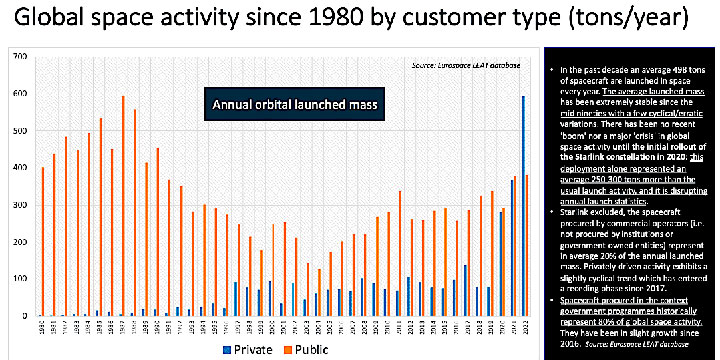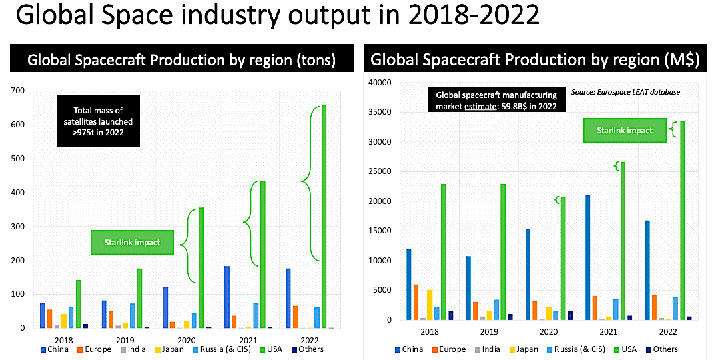 Most of that blue line for 2022 is SpaceX Starlink. (Source: Eurospace)
Most of that blue line for 2022 is SpaceX Starlink. (Source: Eurospace)
TUPPER LAKE, NY — The year 2022 was the first time in history that the private sector launched more tonnage into space than the world’s governments, and the single most important cause is SpaceX’s Starlink broadband constellation.
SpaceX launches Starlinks so often that it’s easy to forget how big a deal it is as a global phenomenon. As the narrator of the talking-bear movie “Ted,” remarked: “No matter how big a splash you make in this world, eventually nobody gives a [damn].”
Nobody except those companies compiling annual trends. Eurospace, the Paris-based organization representing Europe’s space hardware manufacturers.
Eurospace annual facts and figures report, released July 12, 2023, breaks out Starlink to show its remarkable effect it is having on the global space sector.
“In 2022 we had a situation never before seen, where the total mass launched for private customers was higher than total mass launched for public customers,” Eurospace Managing Director Pierre Lionnet said in presenting the study.
“The growth in the [private sector] is 100% linked to the activity of Starlink, deploying an incredible amount of mass in recent years. In 2022, of the almost 1,000 tonnes launched worldwide, more than 500 tonnes were Starlink.
“Starlink mass has outpaced every other space activity in the world,” Lionnet said.
 (Source: Eurospace)
(Source: Eurospace)
But the biggest satellite system ever in terms of launch mass has made a relatively small impact on the revenue accruing to the satellite manufacturing industry, mainly because of SpaceX’s vertical integration. SpaceX builds the Starlink satellites and the Falcon rockets used the launch them, and is owner-operator of the commercial Starlink service.
Lionnet said that Eurospace views SpaceX Founder Elon Musk’s public statement that each Starlink satellite costs $250,000 as a likely reference to marginal cost. Eurospace used a per-satellite cost of $1 million to $1.5 million, depending on the Starlink satellite model. Starlink’s latest version carries laser inter-satellite links and would be more expensive.
 Pierre Lionnet. (Source: Eurospace)
Pierre Lionnet. (Source: Eurospace)
Eurospace takes what might look like a contrarian’s view of the status of the global launch market. Using the total mass launched and the total value of each launch service, it concludes that the global price for getting a payload into orbit has dropped only slightly in recent years, to $27,000 per kilogram.
For SpaceX, launching Falcon 9 rockets filled with Starlink satellites is an internal transaction. Eurospace used SpaceX’s list price of $62 million for its calculations.
A global average launch cost of $27,000 per kilogram
A cost of $27,000 per kilogram to orbit “is very, very far from the oft-stated idea that the price of access to space has been drastically reducing,” Lionnet said. “We are not seeing that. There is a very slight reduction ion price, but nothing really significant, and it’s not a game-changer for space activity.”
The situation is similar for launches to geostationary orbit, which used to be the dominant orbit for telecommunications satellites and the primary source of income for commercial launch-service providers.
Does launch demand fluctuate with launch costs? Not so much, Eurospace says
Eurospace found that there has been slight a price reduction for geo-orbit launches, to around $19,000 per kilogram. But the market has continued a multi-year decline, suggesting little relation to price and demand.
Eurospace has concluded that the market is driven by demand for satellites. “You buy a satellite and then you look for launch,” Lionnet said. “You don’t decide to buy a satellite because the price of launch is low.”
Even so, prospective satellite owners usually assess total cost of ownership of their assets. Launch may not be the top consideration, but because it must be paid in full early in a program, it surely figures in the go/no-go decision on capex.
‘China’s government space program is now the world’s biggest’
Eurospace looks at indicators of the Chinese market — number of launches, diversity of vehicles and satellites and astronaut-carrying capsules to its own space station — and concludes that China’s government space program has surpassed that of the United States in some respects.
Estimates of China’s government space budget do not capture the dynamism of what’s happening in China.
“The institutional space program in China is more important, all things comparable, than the institutional space program of the USA, considering both the civil and military components,” Lionnet said. “China is launching more and more and is surpassing every institutional space program in the world.
“You will see other studies showing the Chinese space budget at $8 billion, compared to $50 billion for the United States. Chinese space budget information is not public anywhere. When you make this kind of budget extrapolation, you should be very careful,” he said.
That could be true. But there was a time when the Soviet Union and Russia were launching more tons into orbit than the United States. One reason was because its satellites did not have the service life of their U.S. counterparts, nor was their technology at the U.S. level. Using tonnage placed into orbit as a measure has its own drawbacks.
Read more from Space Intel Report.
